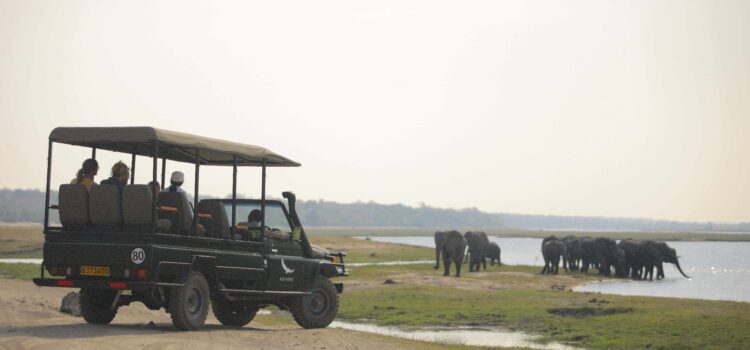Take a couple of minutes to read about the lives of our beloved and quite beautifully functional winged co-habitants. The purpose of this blog post is simply to entice the bird lover, and to maybe remind others of the exciting opportunities that bird-watching in Namibia can offer!
Today, we want to focus on three types of bird categories that will hopefully seduce the bird enthusiast.
We will start with some musical birds. Music is an untainted, limitless and even sacred passion for most and hearing it from birds with no intention of selling it, just amplifies its purity. Birds mostly communicate in two ways, by K and by calling. Singing is the longer, complicated and charmingly melodious version mainly used in a sexual context. Yes, birds in their simplicity still follow the long-forgotten act of courtship, something most humans have come to ignore. Calling, on the other hand, is used as a form of contact and if necessary warning when danger lurks.
Hartlaub’s Babbler is often heard well before it’s seen and it can be quite hilarious to watch them try and out-babble each other. This noisy babbler is mostly found in northern Namibia and Botswana. Their preferred habitats are woodlands near rivers and streams where thick vegetation prevails. Within Namibia their range increases during the rainy season when the rivers in the north of the country flood and there is more wetland available. They are noisy birds, moving around in groups of up to 15 individuals and calling constantly “pa-pa-pa-pa-pa-pa“. They are brown feathered overall with white edges and red eyes, so next time you see one, maybe try and call pa-pa-pa-pa-pa and see if they respond.
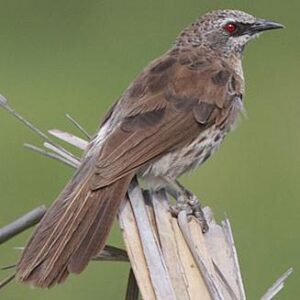
Hartlaub’s Babbler is often heard well before it’s seen and it can be quite hilarious to watch them try and out-babble each other. This noisy babbler is mostly found in northern Namibia and Botswana. Their preferred habitats are woodlands near rivers and streams where thick vegetation prevails. Within Namibia their range increases during the rainy season when the rivers in the north of the country flood and there is more wetland available. They are noisy birds, moving around in groups of up to 15 individuals and calling constantly “pa-pa-pa-pa-pa-pa“. They are brown feathered overall with white edges and red eyes, so next time you see one, maybe try and call pa-pa-pa-pa-pa and see if they respond.
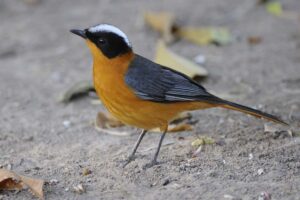
Next on the list are migratory birds. “You who claim to be wise, who would you call the wanderer? The one who leaves without saying goodbye or the one who stays behind with longing in his heart” – Koos du Plessis
So many people spend their lives in one place, never leaving and never seeing the world. That is probably why the life of a migratory bird just seems so much more interesting and just unendingly exiting. The journeys of the avian fraternity can be explained as migration repeated in time and space, therefore predictable in terms of when and where they take place.
Peregrine Falcons are raptors, birds of prey and the fastest flying birds in the world because they have the ability to dive at 321 kilometres per hour. When this predator is on the hunt, all its prey must be alert. These magnificent marauders are also known as wanderers and in actual fact, the word peregrinus in Latin means “to wander”. They migrate as most do, in response to unpredictable circumstances such as rain and drought. The most amazing thing is that this bird has been spotted on every continent on earth, except Antarctica, which speaks volumes about its range. Peregrine falcons mate for life and breed in the same territory each year. The male courts the female for about one month, using aerial displays. This is another romantic bird, one that can make any female peregrine blush.
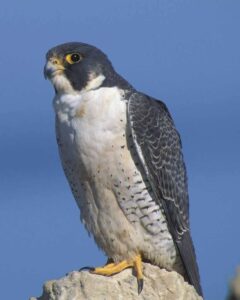
Weighing from 1.2 to 2.7 kilograms, standing height around 80 to 90 centimetres, the Lesser Flamingo is the smallest species of flamingo. Known for travelling northwards along the coastline, before turning right and heading straight to the Etosha Pan to reproduce yearly; one of the very few places where they can successfully breed. There is much speculation as to why this trip takes place. However, the only logical explanation for this migration is that during the wet season the pan fills up with water, not to mention the large amount of salt and clay, which can be very beneficial to them and other birds! Other African breeding sites are Sua Pan, in Botswana and Kamfers Dam in South Africa.
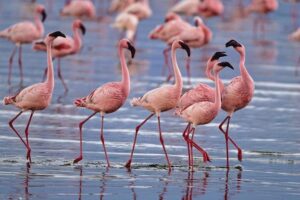
The next category is Roadside birds of Namibia. Driving is one of the best ways to travel in Namibia. The country is vast and distances extensive, so you might as well take a few minutes to stop and watch a bird or two. The birder will have to take it slow and steady on the roads because if you travel at 160 kilometres per hour, you’ll most likely only see the common ostrich and this might be the last thing you ever see. Slow and steady is always the best way, and Namibia has so many birds that you might not make it in time to your next destination if you’re not careful.
The southern yellow-billed hornbill can be seen at roadsides all over Namibia, however, spotting these birds is tricky as they are very active. They have a white belly, grey neck and black feathers with lots of white spots and strips. Their eyes are usually yellow, although brown has also been seen. Their remarkable beaks are huge in comparison to their body, male beaks are roughly 90 millimetres long, whilst the female beaks are on average of 74 millimetres. Mainly active in the morning, during the day and throughout the evening, these busy birds do take some time out at night and sleep high up in trees to avoid being preyed on. These clear yellow beaked birds can be seen turning over debris to find insects and can be seen pursuing insects by hopping after them.
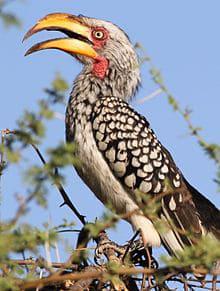
The Lilac breasted roller is often described as the most beautiful bird in the world. The colour of its’ feathers can range from white, purple, blue, and turquoise to green and black. Its’ strikingly beautiful colours and streaming long tail just exude elegance. These charmers are frequently seen in Etosha National Park and are unafraid when vehicles approach, giving people opportunities for spectacular views. Lilac breasted rollers are known for their acrobatic and agile flight aided by their tail streamers which they use as rudders. Its’ agility allows it to do graceful dives, twists and loops when courting. Here’s an interesting fact, Lilac-breasted rollers have uniquely adapted to one natural disaster. While bush fires can be devastating to many animals and birds, these rollers will deliberately hunt near the edges of fires where prey is fleeing and therefore less wary of predators.
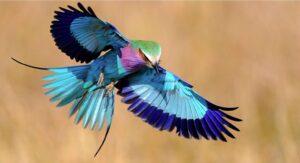
Namibia is known for our abundance of wildlife, breath-taking landscapes and scenery, with all of that comes spectacular birdlife! There’s so much to learn about these mysterious creatures, from unique callings, to colourful feathers and free spirits, they are truly something else.
The next time you are out and about, keep an eye open and let us know if you’ve spotted the noisy Hartlaub’s Babbler, duet singing White browed Robin-chat, well-travelled Peregrine Falcon, Etosha visiting Lesser Flamingo, insect pursuing southern yellow-billed hornbill, or if you’ve been lucky enough to see the most beautiful bird in the world, the lilac breasted roller!
Which bird do you find fascinating?
Send us an email at info@ati-holidays.com


